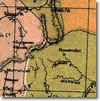|
A town on the northern tablelands of New South Wales, about 715 kilometres north-east of Sydney and 275 kilometres south of Brisbane. The Tenterfield area was originally occupied by the Jukembal Aborigines, who reputedly called it ‘Moombillen’, meaning ‘place of wild honey’. The name Tenterfield was given by Stuart Alexander Donaldson, a pioneer settler (and later the first Premier of New South Wales under responsible government) who took up property in the district in the 1840s. He derived the name from the property of two maiden aunts in Scotland. When the area was gazetted as a town in 1851, the name Tenterfield was retained. Grazing interests were established early with cattle and sheep running on Donaldson’s Tenterfield Station. A bullock track to the coast was completed in 1842 to accommodate the commercial activities of the whole region. For the next twenty years most of New England’s wool passed through Tenterfield on its way to the Clarence River near Tabulam. This was an arduous journey, often taking several weeks and involving the skilful negotiation of heavily-loaded drays through steep terrains and flooded rivers. Nevertheless, as the only means of transportation, the route occupied as many as 500 bullock teams at a time during the 1850s and 1860s. Gold was discovered at Drake in 1858, which, along with the region’s rich silver deposits, added to Tenterfield’s increasing prosperity. So too did the development of alluvial tin mining in the 1870s, when the town’s population almost doubled. In the meantime, Tenterfield acquired all the marks of its new success; a post office (1849), numerous hotels (the first of which, George’s Inn, was established in 1849); banks and general stores; a hospital (1865), a court house (1864 and transferred to its current premises in 1885); a newspaper, the Tenterfield Star (1870); a public school (officially opened in 1864); and a School of Arts (1876). In 1871, in accordance with its growing sense of community and civic pride, Tenterfield was proclaimed a municipality. Services, however, remained rudimentary, one Tenterfield resident remembering that even then ‘there were no roads and streets formed’ and ‘it was a common sight to see a bullock dray bogged in Rouse Street’. The advent of local government and, more importantly, the extension of the Great Northern Railway to Tenterfield in 1886 saw the township develop along more organised lines. Closer settlement, an expanding population and greater economic prosperity consolidated Tenterfield’s role as the region’s communication junction and primary industry service centre. Agricultural pursuits, such as the growing of wheat, maize, oats, and later still, fruit and potatoes, had been tried from the beginning with mixed success. More important for the health of the local economy was the development in the late-nineteenth century of the dairy and timber milling industries, which remained prominent in Tenterfield for much of the twentieth century. But it was the meat industry, established in a big way after the advent of new technology such as refrigeration in the latter half of the nineteenth cenury, which formed the staple of the local economy for the next hundred years. By the 1970s, when the industry was at its peak, the meat works in Tenterfield handled a total of 265,000 animals a year and employed almost 700 people. Tenterfield is the birthplace of some prominent Australians, including the entertaner Peter Allen. Born Peter Woolnough, Allen put Tenterfield in the international pop charts when he released a haunting tribute to his grandfather, George Woolnough, called Tenterfield Saddler. JF Thomas, owner of the Tenterfield Star, early advocate of the Country Party, and the solicitor who defended ‘Breaker’ Morant during the Boer War, was a native of Tenterfield, while the Australian bush poet, AB ‘Banjo’ Paterson, was married there in 1903 in the Presbyterian Church. Perhaps the most momentous and far-reaching event in the history of Tenterfield was the speech delivered by five-times Premier of New South Wales, Henry Parkes, in the town’s School of Arts in 1889. Parkes had been in Queensland garnering support for the idea of an Australian federal union. On his return to Sydney via the Wallangarra railway line, Parkes stopped over in Tenterfield (a seat he once held in the New South Wales Legislative Assembly) and, still preoccupied with the federation question, delivered a stirring oration which many regard as the catalyst for the first Constitutional Convention in 1891. In it he spoke at length about the defensive advantages of federation, and with this in mind, urged Australians to support the lofty idea of union. ‘What the Americans did be war’, he famously declared, ‘the Australians can bring about in peace’. The federation speech is now the focus of an increasingly lucrative tourist trade in Tenterfield. The town presents itself as the ‘Birthplace of Our Nation’ and encourages visitors to see the School of Arts where Parkes delivered his famous speech. Tenterfield, the site of other equally important historic buildings, including the Tenterfield Saddlery (immortalised by Allen’s song), the Tenterfield Railway Station, and the magnificent Tenterfield Post Office, is also surrounded by many natural wonders such as Boonoo Boonoo National Park, Undercliffe Falls and Sundown National Park. The town’s Agricultural Show is held in January or February each year. Other annual fixtures include the Oracles of the Bush festival, a four-day cultural event held in April and involving live performances of Australian Bush poetry, music and art, the Autumn Colour Festival during the same month, and in October, the Spring Wine Festival, Highland Gathering and Springtime in the Highlands (also known as the Federation Festival). References:
Ken Halliday, Call of the Highlands: The Tenterfield Story (Toowoomba: Southern Cross Printery, 1988); GR Henning, ‘Tenterfield: An Economic Overview’, in JS Ryan (ed.), Writing Tenterfield: A Collection of Historical, Cultural and Other Essays (UNE: Faculty of Arts, 2002); and http://www.walkabout.com.au/locations/
NSWTenterfield.shtml
|

